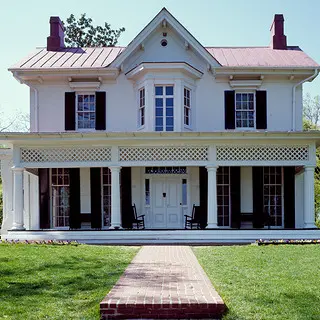
Women in Preservation: Helen Pitts Douglass and the Frederick Douglass Memorial
There are many inspiring and extraordinary tales of passionate women to tell during Women’s History Month. Preservation has our own influential set of female advocates who are paving the way in protecting our county’s heritage, past and present, and we’re excited to highlight some of them this month.

photo by: Wikimedia Commons
Portrait of Helen Pitts Douglass, taken around 1880.
Helen Pitts Douglass was one of the very first of these passionate women in preservation. As the daughter of parents who were both active in abolitionist and suffragist movements, Helen developed early on a determination to stand up for what she believed in. She became a teacher at the Hampton Institute in Virginia, a school founded for the education of black men and women, and was involved with the feminist newspaper, Alpha, before she went to work for Frederick Douglass in 1882.
Two years later, in 1884, Helen and Douglass were married. It was a marriage founded on the same steadfast principles of truth, passion, and perseverance. Neither family approved of the marriage—since Helen, a white woman, was marrying a man who had a black mother and white father—but that didn't stop these two destined to make an impact on history.
“Love came to me, and I was not afraid to marry the man I loved because of his color,” Helen said.
So when the future of their home, Cedar Hill, was left uncertain after Frederick Douglass’ sudden death in 1895, Helen took a stand to save it. When she asked Douglass’ children to set aside the grand home as a memorial to their father, rather than selling it and dividing up the money, they refused. Her next step: borrow the money and buy it herself. She devoted the rest of her life to preserving this piece of history.
Cedar Hill was built in Washington, D.C. between 1855 and 1859 by John Van Hook, an architect and builder from Philadelphia. The house was originally known as Van Hook’s Hill, after Van Hook, but when Douglass bought it in 1877 he renamed it to Cedar Hill for the many cedar trees throughout the property.
In addition to being the home base for one our country’s most noteworthy abolitionists, Cedar Hill was also filled with the memories and stories of 21 grandchildren. Helen knew that this was a place worth saving, and a piece of history that could educate and inspire Americans for generations to come.
At Helen’s urging, Congress officially chartered the Frederick Douglass Memorial and Historical Association (FDMHA) in 1900. Its purpose: to maintain the home and its contents after her death, opening it to the public to further the legacy of her husband and his important work. Her commitment to securing a future for Cedar Hill was a powerful step in the movement for freedom and preservation.
Helen wasn't able to experience the rewards of her great efforts, but her ultimate goal was eventually realized. Upon her passing in 1903, FDMHA took over the property. The organization completed its first restoration of the home in 1922, in partnership with the National Association of Colored Women. Then, in 1962, the estate became a part of the National Park Service, and in 1972 was opened to the public.
Today, visitors of every age and race can step inside the Douglass home and take part in a piece of Helen and Frederick’s lives—a piece of history. Thanks to Helen Douglass, an extraordinary woman and pioneering preservationist, Cedar Hill still stands to tell the compelling story behind her family, share part of the history of the abolitionist movement, and celebrate the many possibilities that come with freedom.
-her_sisterEva_Pitts(center)_LOC.webp)
photo by: Wikimedia Commons
Photo of Frederick Douglass with Helen Pitts Douglass (seated, right) and her sister Eva Pitts (standing, center).

.webp)
